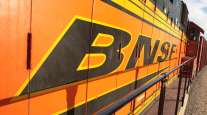BNSF Expects Crude-by-Rail Volumes to Grow After Price Rebound

A 37% rebound in oil prices will boost crude-by-rail shipments as drillers complete more wells and extract more crude that U.S. pipelines don’t have the capacity to handle, Burlington Northern Santa Fe executive chairman Matthew Rose said June 15.
BNSF is preparing for a recovery after shipments of crude and petroleum products by rail fell from a record 17,074 cars the week of Dec. 12 to less than 13,000 in March as crude prices fell by more than half.
The production cuts and strong demand from refineries have led prices to rebound to about $60 a barrel from a six-year low of less than $44 in March. Another increase in oil-by-rail volumes would come as environmental groups and government agencies question the safety of rail transport after a series of high-profile explosions.
“Assuming we see some market indicators — and we clearly will see it now with the price of crude — as it goes up, we’ll see people uncapping wells and start to frack the next well,” Rose said at an Energy Information Administration conference in Washington, D.C. “We think we’re in a much better place to handle that next surge.”
Petroleum traffic on rail lines more than doubled from 2011 to last year, as booming oil production from North Dakota and Canada overwhelmed pipelines and forced shippers to look for alternative transportation methods.
“We — and I would challenge anybody in this room — didn’t see the speed in which domestic shale plays came to us,” Rose said. “At our height, we were hauling about 830,000 barrels a day. It was just enormous. And that’s really in a five-year ramp-up.”
Falling oil prices have caused BNSF to reconsider a shift from diesel to liquefied natural gas to fuel locomotives, Rose said. Market changes or carbon pricing are needed to make such a switch economic at current conditions, he said.




